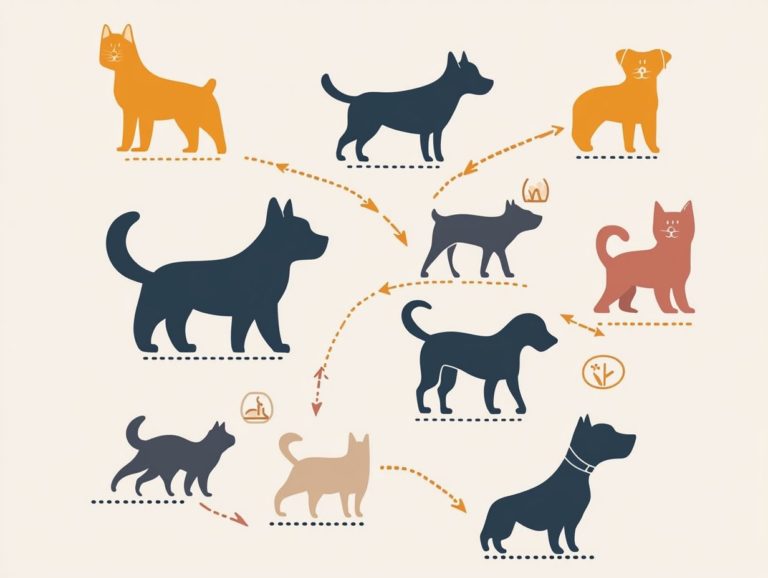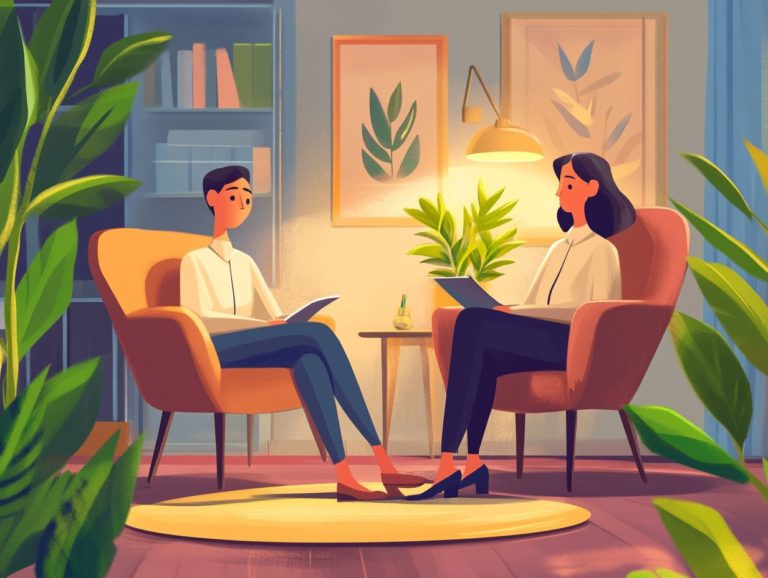How to Use Follow-Up Questions for Clarity
Follow-up questions are potent instruments that can significantly elevate your conversations, deepen your understanding, and build better connections.
Whether you’re engaged in casual dialogue or conducting a formal interview, these questions enhance communication by encouraging a richer exploration of ideas. This article delves into the benefits of follow-up questions, various types you can employ, and key moments when to incorporate them effectively.
You will also discover tips for crafting impactful questions that promote open dialogue and enhance clarity.
Are you excited to elevate your conversation game? Let s dive in!
Contents
- Key Takeaways:
- Benefits of Using Follow-Up Questions
- Types of Follow-Up Questions
- When to Use Follow-Up Questions
- Tips for Asking Effective Follow-Up Questions
- Frequently Asked Questions
- What are follow-up questions and how can they be used for clarity?
- Why is it important to use follow-up questions for clarity?
- How do I know when to use follow-up questions?
- What are some examples of follow-up questions for clarity?
- How can follow-up questions be used in a professional setting?
- Are there any potential drawbacks to using extra questions for clarity?
Key Takeaways:

- Follow-up questions improve communication by clarifying and enhancing understanding.
- There are two key types of follow-up questions: clarifying and probing, each serving a unique purpose.
- Use follow-up questions in conversations and interviews to ensure effective communication.
What are Follow-Up Questions?
Follow-up questions are invaluable tools in your communication arsenal, designed to deepen your understanding and draw out more detailed responses from participants. They cultivate richer dialogue, ensuring your conversations progress meaningfully and often leading to enhanced insights on the topic, whether you’re engaging in sales and marketing discussions or customer service interactions.
These questions can manifest in various forms, such as clarifying or probing inquiries, significantly enhancing team collaboration during research calls or decision-making workshops.
In a customer service scenario, for example, a representative might ask, “Can you explain the issue you re experiencing a bit further?” This not only clarifies the customer s concerns but also signals genuine interest in finding a solution.
Similarly, in sales, following up with a probing question like, “What specific features are most important to you?” allows you to tailor your offers to meet the client’s needs more effectively.
By weaving such questions into your conversations, you foster an environment of open communication that leads to improved feedback and collaboration. Ultimately, skillfully navigating these dialogues boosts participation and facilitates a more comprehensive understanding of shared goals.
Benefits of Using Follow-Up Questions
Using follow-up questions can greatly improve your conversations, whether in professional environments such as sales and marketing or in personal discussions. This approach elevates the dialogue and fosters a deeper clarity.
By actively engaging with participants, you not only enhance your understanding of their needs and perspectives but also encourage feedback givers to express their insights more freely. Ultimately, this practice nurtures a culture of facilitative leadership a style of leadership that supports collaboration and empowerment and hones your effective communication skills.
Improved Understanding
Improved understanding is one of the most significant benefits you can gain from using follow-up questions in conversations. These questions allow for clarification and facilitate a deeper comprehension of different viewpoints.
In customer service scenarios, for instance, when you ask targeted follow-up questions, you can uncover the underlying issues your customers face, enabling you to tailor better solutions to their specific needs. Whether in a hybrid workplace a work environment where employees split their time between home and an office or during a research call, these inquiries have the power to transform initial responses into valuable insights.
When you actively engage through such questions, you create an environment where participants feel valued and heard. Imagine you’re helping a customer who is frustrated with a product. Instead of merely extending an apology, a thoughtful follow-up can reveal whether the issue lies with the product itself or with their service expectations.
This level of active listening identifies key pain points. It also fosters trust, encouraging customers to share more about their experiences.
Similarly, during research calls, delving deeper can uncover nuances that might be overlooked in more superficial discussions, ultimately enriching the data you collect and driving superior outcomes.
Enhanced Communication
Enhanced communication is within your grasp through the strategic use of follow-up questions, which can transform your dialogues into richer and more engaging exchanges. By encouraging others to delve deeper into their experiences and insights, you elevate the quality of conversation and foster understanding feelings in your interactions.
In settings such as meetings where people make choices together or sales discussions, this improved communication can lead to more informed choices. It also paves the way for a nuanced understanding of team dynamics.
Consider, for instance, a team brainstorming session where you, as a leader, actively employ follow-up questions. This approach allows team members to reflect more deeply, articulating their thoughts with greater clarity.
Not only does this clarify ideas, but it also nurtures collaboration; individuals feel their contributions are genuinely valued.
In customer interactions, imagine a sales representative who asks probing questions after initial responses. This technique can uncover hidden needs, allowing for a tailored pitch that resonates. Such practices facilitate productive discussions and convey attentiveness, building trust and rapport among all participants.
Types of Follow-Up Questions

In conversations, several types of follow-up questions can enhance effective communication.
Among the most prevalent are clarifying questions, aimed at ensuring mutual understanding, and probing questions, which delve deeper into a topic to draw out more detailed responses. These questions are invaluable in customer support scenarios, where grasping customer needs is essential to delivering exceptional service.
Clarifying Questions
Clarifying questions play a crucial role in ensuring your communication is effective. They allow all parties to share a common understanding of the topic at hand. By asking these follow-up questions, you can sidestep misunderstandings and clear up any ambiguities, which is especially vital in team collaboration and decision-making processes.
Whether you’re navigating a hybrid workplace or engaging in a research call, these questions can significantly elevate the quality of your dialogue.
In settings like team meetings, simply asking, “Can you explain that point further?” can illuminate complex ideas and prevent assumptions that could derail a project. Similarly, during customer interactions, posing the question, “Do you mean that you are looking for this specific feature?” showcases your attentiveness and ensures that both you and the customer are aligned.
By cultivating an environment where questioning is embraced, you not only enhance communication clarity but also drive improved outcomes through well-informed actions.
Probing Questions
Probing questions are a game-changer! They dive deep into subjects and reveal insights that can transform your understanding. They re an essential tool in the art of effective communication.
By encouraging individuals to unpack their thoughts and feelings, you can gather valuable feedback and insights that truly matter. In scenarios where understanding feelings is key in customer service and team discussions, these probing questions can elevate understanding and create a genuine sense of connection.
For instance, when a customer voices dissatisfaction with a product, asking a probing question like, “Can you share what specifically disappointed you?” allows you to uncover the heart of their concerns.
Likewise, in research, probing questions help you collect rich, nuanced data that might remain hidden with surface-level inquiries. This clarifies the participant’s perspective and shows your empathy and attentiveness crucial elements of understanding feelings.
Embracing this approach not only enhances the quality of feedback you receive but also fortifies the relationship between service providers and their audience. It’s a win-win that fosters trust and understanding.
Start practicing these questions in your next conversation for amazing results!
When to Use Follow-Up Questions
Understanding when to employ follow-up questions can greatly elevate your communication skills across different scenarios, from casual conversations to formal interviews.
These questions serve as powerful tools, especially when clarity is essential or when you aim to delve deeper into a topic. In sales and marketing, using follow-up questions with intention can lead to better understanding and better decision-making, ensuring that every perspective is thoughtfully considered.
In Conversations
In your conversations, follow-up questions are essential for ensuring clarity and fostering engagement among all participants. By asking these questions, you demonstrate active listening and encourage open dialogue, especially in customer service scenarios where understanding the customer’s needs is paramount.
This practice enhances team collaboration and ensures that every voice is heard and appreciated.
For instance, during a team meeting, when a colleague presents an idea, consider asking a follow-up question like, “How do you envision implementing this strategy?” This not only clarifies their proposal but also invites further discussion, paving the way for richer dialogue and allowing everyone to share their related experience.
Such interactions encourage participation from others, allowing team members to share their thoughts and expertise. In customer service settings, a representative might ask a client, “Can you elaborate on the specific challenges you re facing?” This approach leads to deeper insights and tailored solutions, enhancing the overall customer support experience.
These types of interactions strengthen relationships and foster a collaborative atmosphere, which is essential for thriving communication and effective decision-making.
In Interviews

In interviews, asking follow-up questions can unlock powerful insights that can transform your understanding. These questions enable you to dive deeper into specific points, clarify any vague areas, and gather participant feedback that can shape future discussions or decisions.
In research calls, follow-up questions uncover nuanced details, enriching your understanding of the subject matter and improving overall communication skills.
For example, if a research participant shares a difficult experience with a product, asking a follow-up question like, “Can you elaborate on what made that experience challenging for you?” invites them to disclose specific emotions and scenarios that yield actionable insights.
This approach enhances the data you collect and cultivates a more engaging dialogue, making participants feel valued and understood. Effective follow-up questions can unveil underlying motivations or trends that might otherwise go unnoticed, significantly elevating the quality and relevance of your research findings, especially in sales and marketing.
Tips for Asking Effective Follow-Up Questions
Asking effective follow-up questions demands a blend of active listening and strategic questioning techniques, enabling you to keep conversations both meaningful and productive, which is essential in a hybrid workplace.
A crucial tip for your success is to frame open-ended questions that invite elaboration and deeper insights from participants. In customer support scenarios, this method enhances your understanding and cultivates a positive interaction experience, ultimately leading to better solutions and heightened customer satisfaction, fostering a culture of feedback givers.
Mastering follow-up questions can dramatically enhance your interactions don’t miss out on this skill!
Active Listening
Active listening is a vital skill in your toolkit for asking effective follow-up questions. It enables you to fully engage with the speaker and grasp the details of what they are saying. By honing your active listening skills, you can pinpoint key points that deserve further exploration through follow-up questions, ultimately boosting your emotional intelligence and fostering a collaborative team environment. This expertise becomes especially valuable in contexts requiring effective decision-making and customer interactions.
Incorporate techniques like mirroring the speaker’s words and summarizing their key points to significantly elevate your listening abilities. For instance, when a colleague shares their project update, echoing their main ideas can lead to deeper inquiries, uncovering challenges or successes that may not be immediately evident. Maintaining eye contact and using non-verbal cues, such as nodding, not only signals your attentiveness but also encourages the speaker to elaborate further, thereby improving improved dialogue.
By employing these strategies, you not only enhance your understanding but also cultivate trust, paving the way for more productive conversations whether in board meetings, casual discussions, or customer service interactions, especially in a remote work setting.
Open-Ended Questions
Open-ended questions serve as powerful tools in your follow-up arsenal, inviting participants to share their thoughts in depth and provide nuanced responses. By harnessing these questions, you can stimulate rich discussions that uncover valuable insights especially vital in customer service settings where grasping customer needs is paramount. This technique, when paired with probing questions, allows for a more profound understanding of the subject at hand.
For example, rather than simply asking customers if they liked a product, consider inquiring, “What features did you find most beneficial?” This encourages a more extensive conversation, revealing specific preferences and areas for improvement, ultimately enhancing sales and marketing strategies.
In research calls, when you ask participants, “How do you feel about recent changes to policies?” you open the door to nuanced feedback that can inform your future strategies and help in cultural transformation.
During team discussions, posing a question like, “What challenges do you anticipate in the upcoming project?” not only invites team members to voice their concerns but also creates a collaborative atmosphere ripe for brainstorming effective solutions, reinforcing the importance of a strong product team.
Frequently Asked Questions
What are follow-up questions and how can they be used for clarity?

Follow-up questions are additional questions asked after the initial question to clarify or gather more information. They can be used to gain a better understanding of a topic or to ensure clear communication between two parties, enhancing overall culture design framework.
Why is it important to use follow-up questions for clarity?
Follow-up questions allow for a deeper understanding of a topic and can prevent misunderstandings. They also show active listening and engagement, which can build rapport and improve communication skills.
How do I know when to use follow-up questions?
If you feel like you need more information or that you don’t fully understand the topic, it’s a good time to use a follow-up question. You can also use them to confirm your understanding or to clarify any confusion by implementing clarifying questions.
What are some examples of follow-up questions for clarity?
Some examples of follow-up questions include “Can you clarify what you mean by _____?“, “Can you give me an example of _____?“, and “Could you explain _____ in more detail?” These types of questions prompt the speaker to provide more information and ensure clear communication, aiding in decision-making workshops.
How can follow-up questions be used in a professional setting?
In a professional setting, follow-up questions can be used to gather more information, understand a project or task better, and ensure that all parties are on the same page. They can also be used to show active listening and build better relationships with colleagues, particularly in a four-day workweek format.
Are there any potential drawbacks to using extra questions for clarity?
Too many extra questions can disrupt the conversation. This might make the speaker feel like they re being interrogated.
Use extra questions sparingly and respectfully. This helps avoid cultural misunderstandings.






